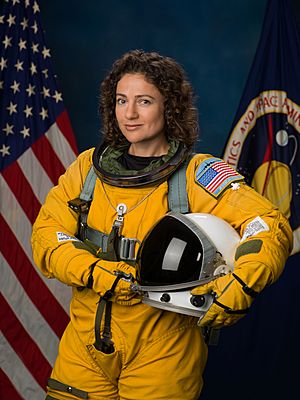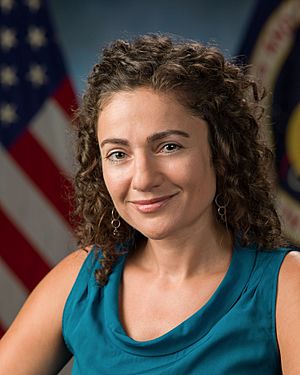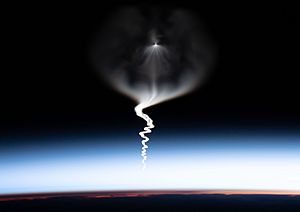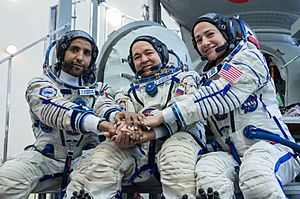Jessica Meir facts for kids
Quick facts for kids
Jessica Meir
|
|
|---|---|
 |
|
| Born |
Jessica Ulrika Meir
July 1, 1977 Caribou, Maine, U.S.
|
| Space career | |
| NASA astronaut | |
|
Time in space
|
204d 15h 19m |
| Selection | NASA Group 21 (2013) |
|
Total EVAs
|
3 |
|
Total EVA time
|
21h 44m |
| Missions | Soyuz MS-15 (Expedition 61/62) |
|
Mission insignia
|
|
| Scientific career | |
| Fields |
|
| Institutions |
|
| Thesis | Blood Oxygen Transport and Depletion: The Key of Consummate Divers (2009) |
| Doctoral advisor | Paul Ponganis |
| Other academic advisors | Bill Milsom (postdoc) Gerald Kooyman |
Jessica Ulrika Meir (born July 1, 1977) is an American NASA astronaut, marine biologist, and physiologist. She used to teach at Harvard Medical School and did research at the University of British Columbia. She studied how emperor penguins dive in Antarctica and how bar-headed geese fly high over the Himalayas.
In September 2002, Meir was an aquanaut on the NASA Extreme Environment Mission Operations 4 (NEEMO 4) crew. In 2013, NASA chose her for Astronaut Group 21. In 2016, Meir trained in a special cave environment as part of ESA CAVES. She launched to the ISS on September 25, 2019, aboard Soyuz MS-15. There, she worked as a flight engineer during Expedition 61 and 62. On October 18, 2019, Meir and Christina Koch made history. They were the first women to do an all-female spacewalk.
Time magazine included Meir in its list of the 100 Most Influential People of 2020.
Contents
Early Life and Education
Jessica Meir was born in Caribou, Maine. Her father, Josef H. Meir, was from Iraq and had a Jewish background. Her mother, Ulla-Britt Meir, was from Sweden. Her father was born in Baghdad in 1925. His family left in 1931 because of unfair treatment. They moved to Mandatory Palestine. He later became a doctor. While working in Sweden, he met Ulla-Britt Karlsson, a nurse. They moved to the US, and Jessica was born in Caribou. Jessica identifies as culturally Jewish and attended synagogue when she was young.
Meir was inspired to go to space by watching Space Shuttle missions on TV. She loved nature, which she learned from her mother. Her father's love for adventure also played a part. Meir said that the bright stars in rural Maine might have also helped her dream of space.
When she was 13, Meir went to a youth space camp at Purdue University. During her studies at Brown University, she also spent time studying in Stockholm University in Sweden. She even ran an experiment on a NASA plane that creates a feeling of weightlessness. Meir earned her Bachelor of Science degree in biology from Brown in 1999. In 2000, she received a Master of Space Studies from the International Space University in France.
Studying Animals and Their Bodies
Meir earned her Ph.D. in marine biology in 2009. She studied how emperor penguins and northern elephant seals dive. She did field work in Antarctica, even scuba diving with penguins under the ice. She also studied elephant seals diving in the Pacific Ocean.
After her Ph.D., Meir did more research at the University of British Columbia. She studied bar-headed geese to see how they handle high altitudes and low oxygen. These geese fly over the Himalayas. In 2012, she continued her research at Harvard Medical School. She then took a break to join the astronaut program.
NASA Career
From 2000 to 2003, Meir worked for Lockheed Martin Space Operations. She helped with experiments for the Human Research Facility at the NASA Johnson Space Center (JSC) in Houston, Texas. She supported experiments that astronauts did on Space Shuttle and International Space Station (ISS) missions. These experiments looked at how the human body changes in space, like bone loss or muscle changes. Meir helped prepare these experiments and trained astronauts. She also supported them from Mission Control.
In September 2002, Meir was an aquanaut on the NEEMO 4 mission. This mission was a joint project between NASA and NOAA. It took place in Aquarius, an undersea research lab off Key Largo. Meir and her team spent five days living underwater. This was like a space training mission, helping them learn to work in extreme conditions.
In 2009, Meir was a semi-finalist for the NASA Astronaut Group 20. In June 2013, she was chosen as one of eight astronaut candidates for NASA Astronaut Group 21. She finished her training in July 2015.
In 2016, she took part in the ESA CAVES mission with other astronauts. This mission involved training in a cave environment, which is similar to space.
During her time in the astronaut office, Meir also worked as a capsule communicator (CAPCOM). This means she was the main person who talked to astronauts in space from Mission Control.
Expedition 61 and 62: Living in Space
In April 2019, NASA announced that Meir would be a flight engineer for International Space Station Expedition 61/62. She launched aboard Soyuz MS-15 with Roscosmos cosmonaut Oleg Skripochka and MBRSC astronaut Hazza Al Mansouri.
Meir, Skripochka, and Al Mansouri launched on September 25, 2019. This was the last flight of the Soyuz-FG rocket and the last launch from the Gagarin's Start launch pad. The crew reached the ISS just six hours later. For a short time, there were nine people on the station. This was because Al Mansouri became the first person from the United Arab Emirates to fly in space. Expedition 60 ended on October 3, 2019. Al Mansouri returned to Earth, and the ISS went back to its usual six-person crew for Expedition 61.
During Expedition 61, Meir was planned to do three spacewalks. These spacewalks were to help install new lithium-ion batteries on the station. On October 18, 2019, Meir did her first spacewalk with her colleague Christina Koch. They replaced a faulty battery unit. This spacewalk lasted seven hours and 17 minutes. It was the first all-female spacewalk in history.

On February 6, 2020, Christina Koch returned to Earth. Meir, Skripochka, and Andrew Morgan then became the crew for Expedition 62. They spent most of this time as a crew of three. Later, three new crew members joined them: Russian cosmonauts Anatoli Ivanishin and Ivan Vagner, and NASA astronaut Christopher Cassidy. They launched on April 9, 2020. Even though their time as a six-person crew was short, they did experiments. They studied how muscles react to long spaceflights. Meir and Cassidy, both from Maine, also spoke to students from Maine. They also appeared on an internet show called Some Good News.
On April 17, 2020, Meir, Skripochka, and Morgan returned to Earth aboard Soyuz MS-15. Meir and Skripochka had spent 205 days in space. Morgan had been in space for 272 days. The Soyuz capsule landed in Kazakhstan. Their departure marked the start of Expedition 63.
Personal Life and Interests
Meir played the flute, piccolo, and saxophone when she was younger. She enjoys reading classic books. For fun, she likes cycling, hiking, running, skiing, soccer, and scuba diving. She also has a private pilot's license.
Besides English, she speaks Russian (which is needed for astronaut training) and Swedish. Even though Meir is American, she also has Swedish citizenship because her mother was born in Sweden. This makes her the first Swedish female citizen in space. She is the second Swedish citizen in space overall, after ESA astronaut Christer Fuglesang.
Astronauts can bring personal items to the International Space Station. Meir chose to bring an Israeli flag and socks with Stars of David and menorahs. Most of her father's relatives live in Israel. Meir has visited Israel twice. The first time was as a teenager with her family. The second time was in 2016 for work as an astronaut. She gave a talk in Haifa, Israel, and took pictures of Israel from space.
On International Women's Day in 2023, Meir shared that she had recently given birth to her first child, a girl. Her partner is Duke Brady, an artist and biologist.
Awards and Honors
Jessica Meir has received several awards, including:
- Philanthropic Educational Organization (PEO) Scholar Award (2008)
- Achievement Rewards for College Scientists (ARCS) Fellowship (2006)
- Lockheed Martin Space Operations (LMSO) Special Recognition Award (2002)
- NASA JSC Space and Life Sciences Directorate Special Professional Achievement Award (2002)
- Lockheed Martin Technology Services "Lightning Award" (2002)
- Honorary Doctor of Technology from Luleå University of Technology, Sweden (2020)
- Sir Charles Sherrington Prize Lecture & Medal (2021), University of Oxford
- President's Lecture & Medal (2021), The Physiological Society of the United Kingdom & Republic of Ireland
See also
 In Spanish: Jessica Meir para niños
In Spanish: Jessica Meir para niños






